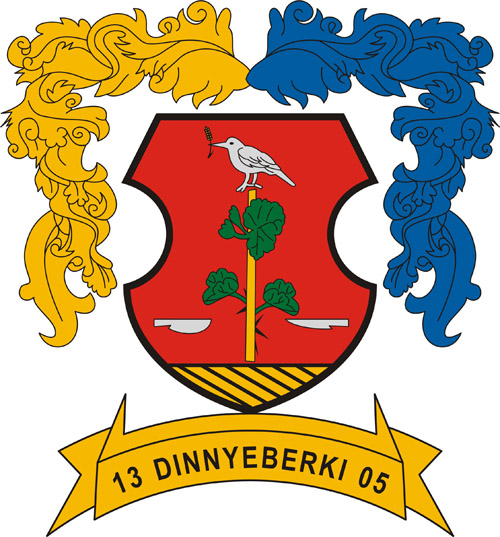
(Baranya megye)
Pajzs a tárcsapajzs modernizált változata fekete kontúrral kiemelve. Pajzs alsó részén a pajzs alsó részével érintkező aranyszínű címerszalag, benne fekete betűkkel a település neve: DINNYEBERKI. Bal és jobb oldalán az évszám, szintén fekete színnel: 1305, amikor a települést először említették az írott források. Dinnyeberkit először említik az írott források. Pajzs teteje felett balra és jobbra kiinduló, majd a pajzs bal és jobb oldalának alsó harmadáig érő barokkos címertakaró. Bal oldali aranyszínű fekete kontúrokkal kiemelve, jobb oldali sötétkék színű, fekete kontúrokkal kiemelve. Pajzs alsó harmadában vágott, barna színű, keresztcsíkozás jelzi a földet, a termékenységet, azt, hogy az itt élők földműveléssel keresték mindennapi kenyerüket. Felette faág öt zöld színű levéllel, felső zöld levélen egy madár áll, amely szürke színű csőre, szeme és szárnya fekete kontúrral kiemelve, csőrében sárga színű búzaszálat tart. Pajzs felső kétharmad része piros színű. Az ábra hasonló Dinnyeberki 1774-es és 1826-os pecsétjéhez. Faág alsó részének bal oldalán ezüstszínű, a címertanban stilizált eke, jobb oldalán szintén ezüstszínű, a címertanban stilizált csoroszlya, amely szintén a földművelés elsődlegességére utal.
(The County of Baranya)
Shield, a modernized version of the traditional spade shield, erect and contoured sable. Below the shield a ribbon or, in which the settlement’s name DINNYEBERKI is inscribed in capital letters sable. On the dexter and on the sinister the date 1305 is inscribed, also sable, signifying the year, when the settlement’s name was first recorded. From the top a Baroque mantling is issuing on the dexter and on the sinister side and it is running down to the two thirds of the shield. On the sinister side mantling is tinctured or and contoured sable, and, on the dexter side it is azure, also contoured sable. In base stripes proper (brown) are borne and they signify the ground (soil), as well as fertility. They serve as references to the fact that the local inhabitants always made their living from agriculture. Above this motif a branch is borne decorated with five leaves, all vert. On the top leaf a the charge of a bird is borne, statant, it is tinctured grey. The bird’s beak, eyes and wings are contoured sable. In its beak bird is holding an ear of corn, or. Fess and chief are tinctured gules. The motives are similar to those of the sealed prints of Dinnyberki of 1774 and 1826. On the sinister side below the motif oöf the branch a stylised ploughshare is borne, argent, on the dexter a stylised coulter. Both charges are references to the primary importance of agriculture.